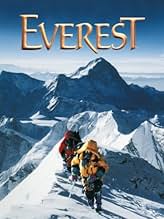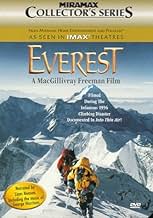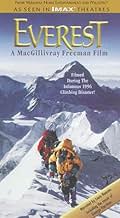Everest
An international team of climbers ascends Mt. Everest in the spring of 1996. The film depicts their lengthy preparations for the climb, their trek to the summit, and their successful return ... Read allAn international team of climbers ascends Mt. Everest in the spring of 1996. The film depicts their lengthy preparations for the climb, their trek to the summit, and their successful return to Base Camp. It also shows many of the challenges the group faced, including avalanches, ... Read allAn international team of climbers ascends Mt. Everest in the spring of 1996. The film depicts their lengthy preparations for the climb, their trek to the summit, and their successful return to Base Camp. It also shows many of the challenges the group faced, including avalanches, lack of oxygen, treacherous ice walls, and a deadly blizzard.
- Awards
- 1 win & 1 nomination total
- Narrator
- (voice)
- Geologist
- (uncredited)
- Helicopter Pilot
- (uncredited)
- Directors
- Writers
- All cast & crew
- Production, box office & more at IMDbPro
There are some good shots of the IMAX expedition's trek up to the base camp. Then "Everest" follows the climbers through the ice fall to their middle camp. The jewel case informs readers that "Everest" was "Filmed During The Infamous 1996 Climbing Disaster Documented in Into Thin Air." To some this might suggest that the film is about the 1996 disaster. But, when planning their expedition, the IMAX producers did not know there would be a disaster. They wanted to document a climb to the summit, and just happened to be on the mountain when the disaster occurred. The film does offer a six-minute interlude about the disaster; and this is appropriate, because some members of the IMAX expedition participated in the rescue efforts. But there is no original footage of the storm, during which visibility was virtually nil. The film's final eleven minutes take viewers to the top of the mountain. There are some spectacular views of the mountain and its surroundings; but these do not adequately exploit the wide-angle panoramic potential that is the special strength of IMAX photography. In a decision symptomatic of the film's unfortunate priorities, on breathtaking views from the summit, the producers chose to superimpose snapshots of the climbers panoplied in climbing suits that concealed both their identities and their emotions.
In a sense, the extras are better than the feature. This is especially true of "The Making of Everest," a 37-minute segment that explains how the movie was made. In this, we learn about the logistical implications of IMAX photography. A frame of film exposed by an IMAX camera is ten times as large as that exposed by a traditional 35mm film camera. IMAX cameras consume film at the astronomical rate of 360 feet per minute—a 500-foot reel yields only 90 seconds of film. Since the customary 100-pound IMAX camera was unsuitable for "Everest," engineers designed a compact 40-pound version specially constructed to withstand the cold. Four sherpas had the task of getting the camera gear up the mountain—separately assigned to carry the camera, the tripod, the film, and the batteries and other accessories. In order to film, the camera crew had to prepare special landings for the tripod, set up all the equipment, and load the film. Only tremendous effort and favorable weather enabled the IMAX expedition to succeed in their venture. But this was not "Candid Camera"—with this technology, there could be no close-up pictures of a climber ascending the Hillary Step.
"Everest" provides five minutes of footage that was omitted from the main feature. This is presented with music, but without commentary. Given the costs and technical requirements of IMAX photography, all the filming was carefully planned. And some omitted shots are so good one wonders why they were not used. There are also the Climbers' Video Journals, in which Segarra, Norgay, and Viesturs discuss their climbing experiences. Without doubt, the most gripping of the extras are the 36 minutes of outtakes from what must have been a lengthy interview of Beck Weathers, the Texas physician who lost both of his hands to frostbite during the 1996 storm. Weathers describes his reasons for climbing and its dangers; and offers his perspective on 1996, especially on his own nearly miraculous survival.
This is a good film; but it would have been improved with more panoramic shots.
- timcon1964
- May 27, 2013
- Permalink
Storyline
Did you know
- TriviaA huge blizzard hit Mt. Everest during filming. Eight people died, and nearly two dozen were trapped on the mountain. The blizzard and its aftermath are the basis for Mort sur le toit du monde (1997). Expedition members interrupted filming to aid the stricken climbers.
- Quotes
Paula Viesturs: The difference between me and Ed is... when we go for a 5-hour bike ride, I call it a workout. He calls it a warm-up.
- SoundtracksHere Comes the Sun
Written by George Harrison
Details
- Release date
- Country of origin
- Official sites
- Language
- Also known as
- Everest, entre la gloria y la tragedia
- Filming locations
- Production companies
- See more company credits at IMDbPro
Box office
- Gross US & Canada
- $87,178,599
- Opening weekend US & Canada
- $364,244
- Mar 8, 1998
- Gross worldwide
- $127,990,128
- Runtime44 minutes
- Color
- Sound mix
- Aspect ratio
- 1.44 : 1
Contribute to this page
























